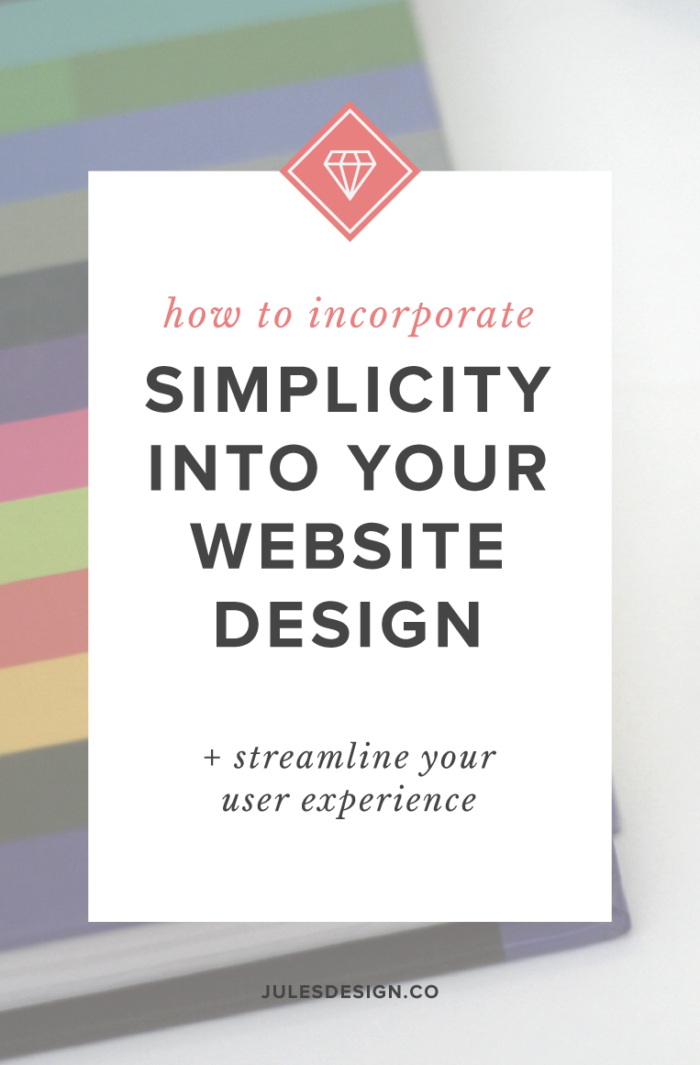50% OFF the entire shop through Cyber Monday! Use Code: BLACKFRIDAY50
Black Friday Sale
When creating custom websites for my clients, I always incorporate simplicity into my design process. If your website has too much content and a bunch of busy graphics it is bound to confuse the person viewing it. They either won’t know what to do first or will be so turned off by the site that they leave entirely. Not good.
The good news is that streamlining your website is pretty easy to do and has a very powerful effect on the people viewing your site! Incorporating simplicity makes it so much easier for users to navigate your site and know exactly what they should do next.

Simplify Typography
Using too many fonts on one website will surely confuse your audience. It makes it difficult for people to tell what is most important on your site because everything seems important. You haven’t established a hierarchy and now, your user doesn’t know where to click next.
To fix this, try sticking with 1-2 fonts that complement your brand identity. You can establish the hierarchy between your headings and body copy in several different ways. If you are only using one font, then you can do this by adjusting the size and weight of the titles on your website. If you are using 2+ fonts then you will need to choose ones that aren’t in the same family but do complement each other. For example, if you choose a Serif font for your headers than select a Sans Serif font for the body copy. Google Fonts has some excellent font options that you can add to any website. They also have a pairings feature that will tell you which font goes well with another font.
When in doubt, always choose fonts that are easy to read. If you know a little bit of CSS then you can also play around with adding letter spacing and line height to your type so that your site is even easier to read.
Add More White Space
A cluttered website will confuse the person on it and, generally, they won’t know where to click first. As I’ve talked about before on my blog, It’s best to guide a user throughout your website in a strategic way. Adding white space around important elements can help to establish hierarchy and ensures that people are drawn to that specific section. It also provides a nice clean aesthetic that is just more pleasing to the eye.
If you want to add more breathing room to your website, try adding some more space between one heading on the page and then the next one. That way, two sections don’t bump right up against each other on the page. Adding this space between sections will ensure that people viewing your website know where one section begins and ends. That way, they can easily find the information that they are looking for.
Simplify your Sitemap
This is a biggie that I really focus in on with my website design clients. Most of my clients come to me wanting a website that is larger than it needs to be. Generally, I’m able to cut and combine pages to make the sitemap smaller. The reason that I do this is that a larger sitemap is confusing. Simplifying it will help to guide users to the most important content on your site.
If you’re unable to make your sitemap smaller, see if you can, at least, remove pages from the main navigation so that things don’t start to look all cluttered up. You don’t want to have a main menu with drop downs galore because people viewing this kind of website will be so overwhelmed by all of the options that they won’t know what to do first! Keep your main nav streamlined by only including the essential pages.
You can place links to less prominent pages, on other, more important pages throughout your website. For instance, you could link to the Our Team page on the About Us page. Or, you could put these pages in a secondary menu, in the sidebar or footer of your website. The footer is a great place to put things like Terms and Conditions and Privacy Policy. The sidebar is an excellent location for blog navigation, like, categories.
I design websites that have a clean and simple navigation by using longer pages with more content on them. For instance, instead of having an About Page with an entire sub-menu of pages like Our Team, What We Do, How We Can Help, and Testimonials, I combine this content onto one page with sub-headings and clear dividers for each section to keep things organized.

These are just 3, of many ways, that you can incorporate simplicity into your website design. I chose these 3 because they are all fairly easy to implement whether you’re working with a designer or DIY-ing your website.
If you want to dive a little deeper into simplicity and user experience then you can also simplify a few other things! Take a look at anything that is causing clutter on your website and see if you can streamline it. This could include things like cutting unnecessary copy, removing photos that aren’t relevant, and only including one call to action on each page. The possibilities are endless!
You only get one homepage. Let’s make it work harder. Get a free expert review of your homepage, so it actually attracts your dream clients!
Free Homepage Health Check
Copyright 2022 - All Rights Reserved | Website made by Jules Design (of course!)
Terms & Conditions
Privacy Policy
We are a Richmond Virginia based website design and brand identity design studio for dietitians, nutritionists, health coaches, fitness professionals and wellness entrepreneurs. We love working with brands with compassion in the health space.
